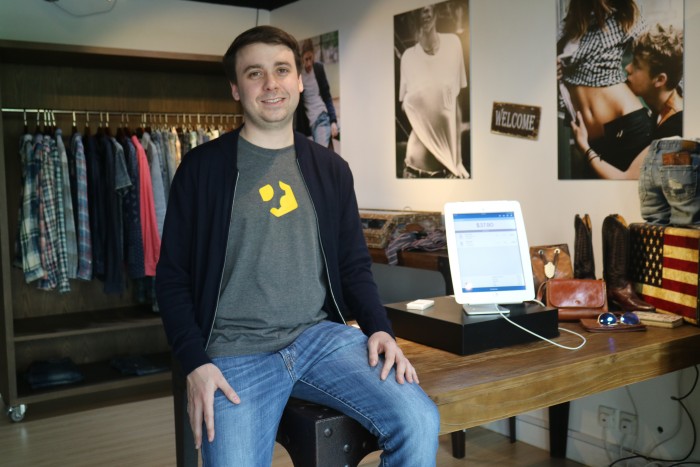
Hello, bot – How everybody will be talking to (and about) AI
share on
Seeing as we still plaster our heads to smartphone screens for hours on end each day, it is hard to believe that apps may have reached the end of the road. Yet, studies consistently show that consumers’ enthusiasm has waned as they find downloading apps and navigating between them a hassle.
Consumers have condensed their screen time to just a handful of apps, with Facebook Messenger and WhatsApp leading the pack.
With dwindling opportunities to make money from mobile apps, together with Facebook’s roll-out of AI chatbot tools, and hybrid products such as Google Allo, a smart messaging app with an integrated AI assistant, we see brand names such as Starbucks, KLM, The Wall Street Journal and H&M starting to look at AI chatbots as another route to making mobile software that can better engage their consumers.
To make it simple, AI chatbots are a machine-learning tool that can understand the customer through a wide variety of transactions and digital footprints.
It can interact with users on social media platforms or apps in several natural ways, including text and speech, and can even help customers navigate products on sale, or give personalised recommendations based on its predictive abilities.
Take Skyscanner’s Facebook Messenger bot as an example. Launched in May last year, the English-based AI bot is available globally to let users receive real-time search trends and keep track of the cheapest flights through conversational Q&A sessions.
The bot then displays scheduled flights and prices, and provides a link to Skyscanner’s website to complete the booking.
CNN’s Kik bot, on the other hand, targets young readers; it focuses on giving users the basics on big news stories. Readers can learn more about news by tapping a series of conversation prompts that offer specific details about what has been going on, how long it has been going on for, who the major players are, as well as relevant locations.
In both formulas, companies use tools available on messenger apps such as Facebook or Kik to create their own text-based personal assistant at no extra expense.
“Compared to creating an app, which can cost $200,000 to $300,000, chatbots are cheaper and easier to make, as there are several ready-made, rule-based chatbot tools available in the industry,” said Alex Wong, cofounder and chief operation officer at TravelFlan.
The Hong Kong-based start-up, which has just raised an undisclosed amount of angel-round funding from 500 Startups, Silicon Valley’s most active and influential investors, makes use of AI chatbot tools on WhatsApp and Facebook Messenger to provide free travel concierge services through Chinese and English conversations on two instant apps for travelling in Korea, Japan, Taiwan and Hong Kong.
Under its services, you may ask the digital assistant to recommend three economic flights and hotels for a family trip; command it to plan a five-day trip to Seoul; call for its help on insurance problems during the trip; ask for an update on real-time transportation; or even ask the robot to help with bookings and reservations. Your wish is its command in real-time. As of now, the bot does most of the work, but occasionally staff take over when the bot lacks experience in a certain area.
The company generates its revenue by partnering with travel or airline companies, for example, local tour agencies, to upscale their product, and share the commission.
Its most recent partnership was with a North Asia-based low-cost carrier Jeju Air.
Since its launch six months ago, the company claimed it has attracted 50,000 active users, with Hong Kong customers accounting for more than 60% of the user base.
“From this figure, you can see that consumers are generally mature enough for these types of digital assistants,” Wong said.
“The return on investments is encouraging as well, as the conversion rate stands between 20% and 30% on our services so far, while that of other ecommerce websites usually stands at lower than 5%. The retention rate with the AI chatbot is also much higher.”
In another case, shopping centre Westfield reached an average of 370 customers per day with a cognitive retail app and boasted an 11% conversion rate during the 2015 holiday shopping season, according to IBM.
These promising figures are due to the empowerment of customer services, Wong suggested.
“Let’s say you phoned in a customer service request to the bank, only to be transferred multiple times and have to repeat your issue,” he said.
A chatbot, unlike a human, can field questions 24 hours a day, repeatedly and accurately without becoming tired or irritated. Everything is resolved instantly by chatbots, who are always polite.
From a business perspective, brands using bots can easily gather information, understand context and anticipate needs.
“It is guiding the consumer through their journey, which is more engaging. Compared to humans, AI chatbots can make use of business intelligence to make recommendations, which creates a more personalised customer experience.”
Similarly, when Starbucks announced it would launch a “conversational ordering system” dubbed My Starbucks Barista to let customers place their orders via voice command or a messaging interface, the brand’s chief strategy officer Matthew Ryan said the company’s investment in this new technology would “catch customers in the moment” so that messaging becomes more targeted and more personalised.

The beverage company expects to complete the roll-out by early 2017.
Tofugear, a Hong Kong-based customised omni-channel retailing platform, holds similar beliefs. The company uses machine learning technologies powered by Microsoft to share predictive data to its front-end staff. Smartphones are used as a digital identifier, and staff can draw insights from the results generated from AI’s predictive analysis to instantly find out which product their customers are interested in before they even enter the shop.
Carson McKelvey, managing partner at Tofugear, said the company was looking to further leverage AI’s predictive features to enhance retailers’ operations.
“From my own experience, logistics might find most value from AI chatbots,” he said.
Imagine when you are waiting for a package amid a tight schedule, you can just type on an e-commerce website, ‘where is my order?’, to get a response, ‘your package is 20 minutes from your house, chill’.
"All these processes are done in a way that the consumer is very familiar with, but can greatly enhance the customer experience."
Andy Cheung, partner business evangelist, developer experience group at Microsoft added, “These conversations exist not only between brand and customers. It also exists between the front-end chatbot, which is responsible for assisting customers, and the operation bot from the logistic company, which answers inquiries regarding the packages. These types of between-bot conversations will eventually be the future.”
Currently in Hong Kong, TravelFlan’s Wong said banking and travelling companies were the first two industries to recognise AI chatbots’ potential. However, half of the companies he has approached showed interest in the technology, but many hesitate to be the first in the industry to examine it.
“The most common response I would get is, have any of their rivals started doing it? Or can you come back when there are more case studies in the market?” Wong said.
In other cases, companies are held back by the effort it would take to prepare a well classified data base, and to equip the AI chatbots with soft-selling skills in a series of testing, feature submission and feature promotions.
“It is true that an AI chatbot does not engage the audience like magic, and large companies may take around a year to get the application established.”
Mayumi Nakayama, of Shiseido’s beauty creation development, said there were challenges to overcome at the start.
The Japanese beauty brand worked with NTT Communications to release the beta version of a beauty counselling AI chatbot called Beauco in Japan in September 2015 to answer questions about beauty treatments, make-up tips and product information.
“At first, conversations didn’t flow very naturally,” she said, which was partly to do with the time the robot took to learn conversations.
Upon programming adjustments and repeated testing, conversation accuracy was improved in the final app.
“More users started chatting about topics not directly related to beauty, and that was how we want the app to be used: we hope Beauco becomes the best friend of women in their teens and twenties.”
Despite the struggles that traditional companies are going through with new innovations, Tofugear’s McKelvey believes AI applications are the next inevitable step in the business world.
“Eventually, bots will be able to handle very administrative tasks in a very easy way. As AI is able to anticipate needs and proactively talk to you, it’ll get more exciting,” he said.
“Transformation is not something we can control, it will eventually happen. The question is more about whether your company is ready to move forward to this level of branding; to innovate for a new level of personalisation, which will definitely add value to the business.”
share on
Free newsletter
Get the daily lowdown on Asia's top marketing stories.
We break down the big and messy topics of the day so you're updated on the most important developments in Asia's marketing development – for free.
subscribe now open in new window



